Catholic Customs
 |
 |
 |
 |
 |
 |
 |
Sacred Customs of Holy Thursday - III
The Silence of the Bells
on Holy Thursday
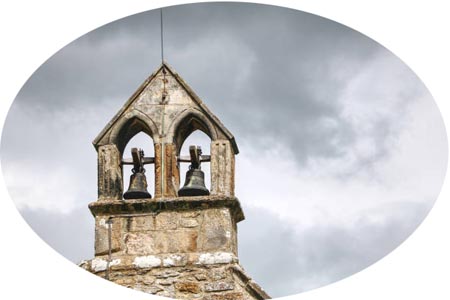
The ceremonies of Holy Thursday’s "Mass of the Lord's Supper" inspired beautiful customs that took root in our Catholic forefathers. The priest wears white vestments during this solemn Mass and the "Gloria" is sung to the triumphant sound of ringing bells. Then, after the "Gloria" is sung, all the bells in Rome and throughout all of the Catholic world are silenced out of respect for Our Lord's Passion.
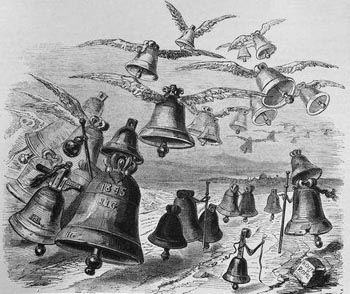
The church bells fly to Rome to receive a papal blessing
In France, Belgium, Luxembourg, Germany, Austria, Czechia, Hungary and throughout Central Europe, the people would say, "The bells have flown to Rome." According to folk belief, the bells from all the church steeples around the world fly to Rome after the Holy Thursday. They wait there until Easter morning when they journey back to their homes to spread the joyous proclamation of Our Lord's Resurrection to all of Christendom. (1)
There were various opinions as to what the bells would do during their stay in Rome. In Luxembourg, the bells were said to fly to Rome for confession. Some Czechs and Austrians said that the bells went to receive the Pope’s blessing. Yet others affirmed that the bells made a pilgrimage to the tombs of the Apostles and would sleep on the roof of St. Peter's Cathedral until the time for their return. (2) The French and Belgians said that the bells flew to Rome to receive the Easter eggs and other sweets that they would bring back with them on their return.
Wooden clappers replace the bells
Wooden clappers, known as crotalum in Latin, were used to create a clattering noise that took the place of the bells during the Mass liturgy and to announce the Angelus hours (6:00 a.m., noon, 6:00 p.m.) and church services throughout the Triduum. In Spanish speaking countries, men of penitential confraternities often sounded clappers during the Passion processions.
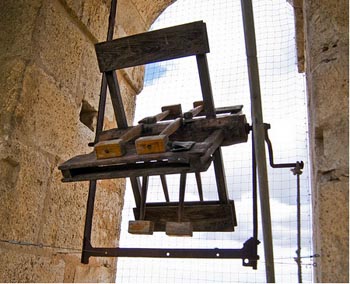
A large clapper in the belfry of a Spanish church; below Members of a Bellringer Confraternity ring the large clapper in the Cathedral of Morelia, Mexico
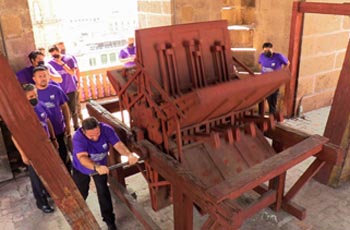
Some churches, especially in Palestine, Spain and the Philippines, had these large rattles in their belfries up until the 20th century to call the people to assemble in place of bells during the Triduum. And even today there are churches in Spain, Latin America and the Phillipines who are striving to revive this custom.
The hand held clapper designs varied from region to region. Some were simple wood clappers that sounded when a man swung the clapper, causing a small hammer to strike the end of a wooden board that was attached to the handle.
Other designs, called ratchets, were more complex with wooden gears and cranks in a sound box replacing the simple board and hammer. Ratchets that had sound boxes produced lighter rumbling or purring sounds instead of the rattling noise of the clapper.
A rattle used in Spanish countries was a wheel of fixed boards in the shape of a blade, between which hung mallets which, when the wheel rotated, produced a great roaring sound. In some places, simple wooden hammers were used instead of the clappers to produce the desired sound. In many parts of France, the people brought small wooden hammers to church to beat them against the chairs and benches, and sometimes the outside walls of the church as a replacement for the church bells. (4)
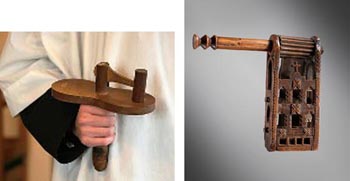
Different varieties of the clappers
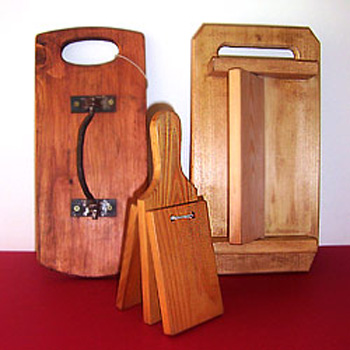
The boys organically formed groups under one leader (the rattling master) who led the boys in the performance of their duty. Czech boys were especially assiduous in carrying out their duties because they desired to frighten Judas away by their loud rattling. (6) Hungarian boys slept in the barn of the boy who lived closest to the church in order to be punctual in their duty. (7)
Special rhymes or calls unique to each region were recited as the boys made their rounds. The rhymes always announced the hour and often referenced the liturgical focus of the day or the proximity of the day to Easter. In Germany, the rhymes admonished those who were lazy and slow to answer the summons and make haste to arrive at the church services. (8)
One common rhyme in Austria was: "We clatter, we clatter, we clatter for the Angelic Salutation, every believing Christian must pray. Fall down, fall down on your knees, pray one Our Father and three Hail Marys." (9)
In the town of Alsdorf, Germany, in the Eifel Mountains, the villagers were awakened on Holy Saturday with the call to assemble at the church to visit the Sepulcher erected for Our Lord: Get up, get up to the holy grave, it's about time.
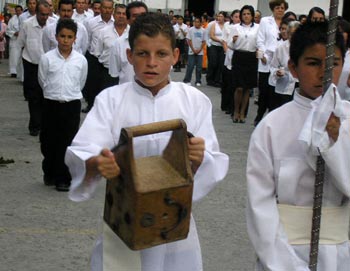
A boy with a rachet in Pacora, Colombia summons all to church; below, German boys on their clappers
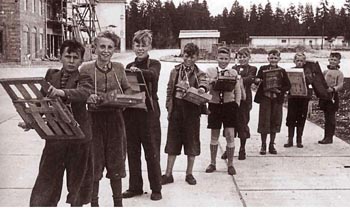
Up, up, dear ones, let the lazy lie,
Let them lie in their rest,
We hurry to the holy grave with pleasure! (10)
To reward the boys’ good service, on Easter Sunday or Holy Saturday the boys would troop from door to door asking for Easter eggs, coins or sweets, with eggs being the traditional gift. Boys from Picardy, France, were also rewarded with eggs after they chanted for the Holy Thursday services. (11)
Holy Saturday was a popular day for the boys to make their rounds. As the boys stopped at each house, they recited a popular rhyme like this one: "We have rattled for the Holy Sepulcher and ask for a genial gift."
At times the boys beckoned the women in each house with these words: "Women, get up to bake cakes! Hurray, hurray, the cake is rising!" In some villages in Rhineland, the boys, who were twelve in number in honor of the Holy Apostles, were each obliged to give the sacristan one of their eggs. (12)
Thus was the rattling rewarded, that rattling that had so stirred the people during the most sacred days of the year.
Would that Catholics world over should make an effort to bring back the clappers into cities, churches and homes so that mankind would again be stirred by the rattling that announces the Sacred Passion of the King of Kings. Simple wooden hammers or sticks could replace the dinner and Angelus bells in homes, allowing the somber atmosphere of the Triduum to penetrate daily life.
No effort is too small to honor Our Lord in a world that seems intent only on adding to His sufferings. Let us return to Our King the throne that He deserves in society.
Continued
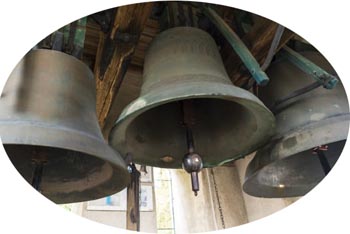
- Dorothy Gladys Spicer, Festivals of Western Europe (New York: The H. W. Wilson Company, 1958), pp. 19, 46.
- https://www.myczechrepublic.com/czech_culture/czech_holidays/easter/green_thursday.html
- http://www.brauchtumskalender.at/brauch-110-ratschen
- E. I. Robson, A Guide to French Fêtes (London: Methuen and Company, 1930), p. 77.
- Sophie Hodorowicz Knab, Polish Customs, Traditions, and Folklore (New York: Hippocrene Books, 1996), p. 100.
- https://www.myczechrepublic.com/czech_culture/czech_holidays/easter/green_thursday.html
- https://www.arcanum.com/hu/online-kiadvanyok/MagyarNeprajz-magyar-neprajz-2/vii-nepszokas-nephit-nepi-vallasossag-A33C/szokasok-A355/jeles-napok-unnepi-szokasok-A596/aprilis-A6D6/husveti-unnepkor-A6F1/nagyhet-A71C/
- http://www.brauchtumsseiten.de/a-z/g/gruendonnerstag-in-der-eifel/home.html
- http://www.brauchtumskalender.at/brauch-110-ratschen
- https://second.wiki/wiki/ratschen
- Robson, A Guide to French Fêtes, p. 77.
- https://second.wiki/wiki/ratschen

Posted March 25, 2024
______________________
______________________
 |
 |
 |
 |
 |
 |


